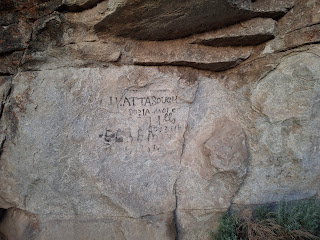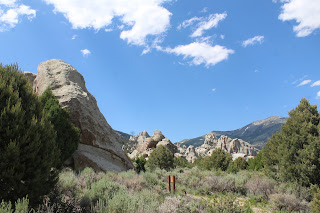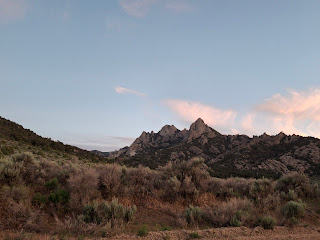 |
| Daylight at City of Rocks |
The road had the effect of peeling away layers of civilization, like progressing through these mountains would hold the world’s worries at bay, if only for one night.
Getting out there was not complicated. I weaved through a few small towns and mountains ranges before winding into the Upper Raft River Valley. Green mountains, plenty of farms and ranches, and no traffic weaved a tapestry of relaxation. The valley ahead held many surprises stemming from its signature granite rock formations known as the City of Rocks.
 |
| Castle Rocks State Park |
While well-known to the Shoshone peoples, the name City of Rocks sprang from the wagon train days, when the granite spires were a landmark on the California Trail. The wagon trains crossed Granite Pass into Nevada a short distance to the west.
Bypassed by the railway and lightly settled by the ranchers, City of Rocks looks unchanged from its pioneer days, and remains the best-preserved section of the California Trail.
Protections came piecemeal. The Idaho Legislature protected a separate parcel of the same geology in 1957 as Castle Rocks State Park. While on federal land, the rest of City of Rocks received protection as a national reserve in 1988 to allow practices like hunting and cattle grazing that other park designations would forbid. Today the Idaho Department of Parks and Recreation administers both sites.
Outside of the granite crags, the valley was not flush with shade. A few creeks emerged from the mountains, and provided enough water to fill the fishing pond at the state park. I decided to start at Castle Rocks since my day pass expired that night.
Along with the signature rocks, the park crafted an oasis rich with bird species I didn’t normally encounter. With more than 120 species found in late May and early June, the Almo and Upper Raft valleys are known for birding.
The Albion Mountains offer migratory birds a respite between the Snake River Plain and the northern reaches of the Great Salt Lake. I received a healthy dose of birdsong at the pond and the park’s granite monoliths.
 |
| Castle Rocks residents |
 |
| Castle Rocks pond |
The hills were rich with wildflowers and pollinators, with bees and butterflies moving about. I did not spot the apex avian predator of the valley, the golden eagle, which can have territory of 60 square miles.
I spent some time with the cattle lounging, although one cow was none too fond of me observing her three calves. The cows have replaced the bison, who would have grazed here till they were wiped out locally in the 1870s. Other than their absence, the valley felt remarkably untouched. The more time I spent here, the more relaxation seeped in.
 |
| Campsite view |
Lodging around Almo is scarce outside campgrounds. The two public campgrounds at City of Rock and Castle Rocks fill quickly, but two private operators run ample campgrounds near the turn for City of Rocks Road. The campsite was at the far end of the campground, several spots from anyone else.
I had an enviable view of Castle Rocks and cooler of Idaho beer. But I also had a total lack of shade. I spent the late afternoon reading in the shadow of my car, accompanied by the wind gusts and kids playing in the campground. An eternity passed before the shadows lengthened. Following the afternoon in the dust, I had access to a brand-new shower installed by the campground owners.
Clean by sunset, I finally sat at my site's picnic table and watched the Milky Way slowly pop into view as the light waned.
I repeated my Craters of the Moon strategy with City of Rocks, waiting till morning for my main visit. At this hour I could feel what it would have been like for the Shoshone and the wagon trains. The birds and insects struck up an hour before first light.
 |
| Twilight campsite view |
I didn’t venture far off the main road, as City of Rocks infrastructure leans on narrow, high-clearance dirt roads. The reserve is best known for its climbing routes, and it’s long been decided I best stay firmly on the ground.
Gradually light crept upon the granite formations. Evidence of the past emerged. People wrote their names in axle grease on several remarkable monoliths, most notably on Camp Rock, the common overnight stop in City of Rocks.
All roads south turned to dirt at City of Rocks Road. I had to retrace my path north then jog east. I didn't mind one last ride through the Upper Raft; it crafting a relaxing scene at any hour.
The churning fire of sunrise prepared to rise above the mountains. Something unfamiliar vaulted int the road – a western spotted skunk. Its poofy tail and white marbling on its black fur made it seem alien in this quiet country. Moving no faster than an opossum, I braked hard as the skunk ignored me and crossed back into the shelter of the sagebrush.
 |
| Trail markings |
 |
| Homestead ruins |









No comments:
Post a Comment